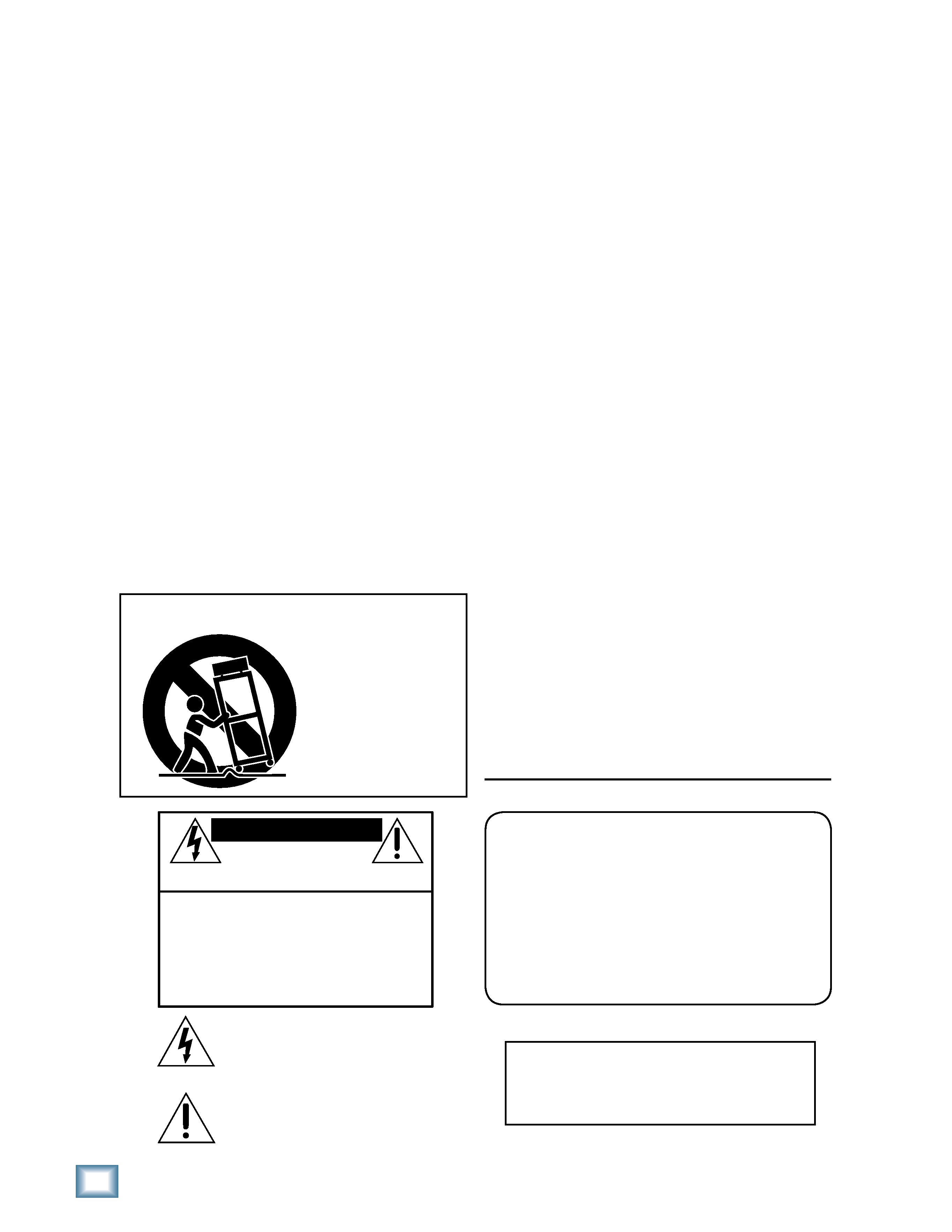
OWNER'S
MANUAL
STUDIO RECORDING PREAMP
with 192kHz FIREWIRE I/O

2
ONYX 400F
ONYX
400F
1. Read these instructions.
2. Keep these instructions.
3. Heed all warnings.
4. Follow all instructions.
5. Do not use this apparatus near water.
6. Clean only with dry cloth.
7. Do not block any ventilation openings. Install in accordance with the
manufacturer's instructions.
8. Do not install near any heat sources such as radiators, heat registers,
stoves, or other apparatus (including amplifiers) that produce heat.
9. Do not defeat the safety purpose of the polarized or grounding-type
plug. A polarized plug has two blades with one wider than the other.
A grounding-type plug has two blades and a third grounding prong.
The wide blade or the third prong are provided for your safety. If the
provided plug does not fit into your outlet, consult an electrician for
replacement of the obsolete outlet.
10. Protect the power cord from being walked on or pinched particularly at
plugs, convenience receptacles, and the point where they exit from the
apparatus.
11. Only use attachments/accessories specified by the manufacturer.
12. Use only with a cart, stand, tripod, bracket, or table specified by the
manufacturer, or sold with the apparatus. When a cart is used, use
caution when moving the cart/apparatus combination to avoid injury
from tip-over.
13. Unplug this apparatus during lightning storms or when unused for long
periods of time.
14. Refer all servicing to qualified service personnel. Servicing is required
when the apparatus has been damaged in any way, such as power-
supply cord or plug is damaged, liquid has been spilled or objects have
fallen into the apparatus, the apparatus has been exposed to rain or
moisture, does not operate normally, or has been dropped.
15. This apparatus shall not be exposed to dripping or splashing, and no
object filled with liquids, such as vases, shall be placed on the apparatus.
16. This apparatus has been designed with Class-I construction and must
be connected to a mains socket outlet with a protective earthing con-
nection (the third grounding prong).
17. This apparatus has been equipped with a single-pole, rocker-style AC
mains power switch. This switch is located on the front panel and
should remain readily accessible to the user.
18. This apparatus does not exceed the Class A/Class B (whichever is
applicable) limits for radio noise emissions from digital apparatus as
set out in the radio interference regulations of the Canadian Department
of Communications.
ATTENTION -- Le présent appareil numérique n'émet pas de bruits
radioélectriques dépassant las limites applicables aux appareils numériques de
class A/de class B (selon le cas) prescrites dans le réglement sur le brouillage
radioélectrique édicté par les ministere des communications du Canada.
19. Exposure to extremely high noise levels may cause permanent hearing
loss. Individuals vary considerably in susceptibility to noise-induced
hearing loss, but nearly everyone will lose some hearing if exposed to
sufficiently intense noise for a period of time. The U.S. Government's
Occupational Safety and Health Administration (OSHA) has specified
the permissible noise level exposures shown in the following chart.
According to OSHA, any exposure in excess of these permissible limits
could result in some hearing loss. To ensure against potentially danger-
ous exposure to high sound pressure levels, it is recommended that all
persons exposed to equipment capable of producing high sound pres-
sure levels use hearing protectors while the equipment is in operation.
Ear plugs or protectors in the ear canals or over the ears must be worn
when operating the equipment in order to prevent permanent hearing
loss if exposure is in excess of the limits set forth here.
Important Safety Instructions
WARNING -- To reduce the risk of fire or
electric shock, do not expose this apparatus
to rain or moisture.
Duration Per Day
Sound Level dBA,
Typical
In Hours
Slow Response
Example
8
90
Duo in small club
6
92
4
95
Subway Train
3
97
2
100
Very loud classical music
1.5
102
1
105
Tami screaming at Adrian about deadlines
0.5
110
0.25 or less
115
Loudest parts at a rock concert
PORTABLE CART WARNING
Carts and stands - The
Component should be used
only with a cart or stand
that is recommended by
the manufacturer.
A Component and cart
combination should be
moved with care. Quick
stops, excessive force, and
uneven surfaces may cause
the Component and cart
combination to overturn.
CAUTION
AVIS
RISK OF ELECTRIC
SHOCK
DO NOT OPEN
RISQUE DE CHOC ELECTRIQUE
NE PAS OUVRIR
CAUTION: TO REDUCE THE RISK OF ELECTRIC SHOCK
DO NOT REMOVE COVER (OR BACK)
NO USER-SERVICEABLE PARTS INSIDE
REFER SERVICING TO QUALIFIED PERSONNEL
ATTENTION: POUR EVITER LES RISQUES DE CHOC
ELECTRIQUE, NE PAS ENLEVER LE COUVERCLE. AUCUN
ENTRETIEN DE PIECES INTERIEURES PAR L'USAGER. CONFIER
L'ENTRETIEN AU PERSONNEL QUALIFIE.
AVIS: POUR EVITER LES RISQUES D'INCENDIE OU
D'ELECTROCUTION, N'EXPOSEZ PAS CET ARTICLE
A LA PLUIE OU A L'HUMIDITE
The lightning flash with arrowhead symbol within an equilateral
triangle is intended to alert the user to the presence of uninsulated
"dangerous voltage" within the product's enclosure, that may be
of sufficient magnitude to constitute a risk of electric shock to persons.
Le symbole éclair avec point de flèche à l'intérieur d'un triangle
équilatéral est utilisé pour alerter l'utilisateur de la présence à
l'intérieur du coffret de "voltage dangereux" non isolé d'ampleur
suffisante pour constituer un risque d'éléctrocution.
The exclamation point within an equilateral triangle is intended to
alert the user of the presence of important operating and maintenance
(servicing) instructions in the literature accompanying the appliance.
Le point d'exclamation à l'intérieur d'un triangle équilatéral est
employé pour alerter les utilisateurs de la présence d'instructions
importantes pour le fonctionnement et l'entretien (service) dans le
livret d'instruction accompagnant l'appareil.

Part No. SW0204 Rev. A 5/05
©2005 LOUD Technologies Inc. All Rights Reserved.
3
Owner's Manual
Owner'
s
Manual
Don't forget to visit our website at www.mackie.com for more
information about this and other Mackie products.
Table of Contents
Introduction................................................................................................................................. 5
Getting Started ...........................................................................................................................6
Zero the Controls................................................................................................................................................................... 6
Connections............................................................................................................................................................................. 6
Set the Levels .......................................................................................................................................................................... 6
Set the Console Control Panel ........................................................................................................................................... 6
Start Recording to DAT .........................................................................................................................................................7
Start Recording to DAW........................................................................................................................................................7
Hookup Diagrams.......................................................................................................................8
Onyx 400F Features ..................................................................................................................12
Front Panel..............................................................................................................................................................................12
1. Power Switch...................................................................................................................................................................12
2. CLOCK SOURCE Indicators .........................................................................................................................................12
3. FireWire Indicator .........................................................................................................................................................12
4. MIDI Indicators..............................................................................................................................................................12
5. CONTROL ROOM Level...............................................................................................................................................12
6. PHONES 1 and 2 Level ..................................................................................................................................................12
7. PHONES 1 and 2 Outputs.............................................................................................................................................12
8. 48V Phantom Power Switch ..................................................................................................................................... 13
9. Channel GAIN ................................................................................................................................................................ 13
10. Signal Level Indicators............................................................................................................................................... 13
11. Instrument Switch ....................................................................................................................................................... 13
12. Instrument Input ......................................................................................................................................................... 13
Rear Panel ...............................................................................................................................................................................14
13. MIC/Line Inputs...........................................................................................................................................................14
14. INSERTS ..........................................................................................................................................................................14
15. LINE IN (Channels 5-8)................................................................................................................................................ 15
16. LINE OUT........................................................................................................................................................................ 15
17. CR OUT............................................................................................................................................................................ 15
18. WORD CLOCK IN/OUT.............................................................................................................................................. 15
19. FIREWIRE.......................................................................................................................................................................16
20. MIDI IN/OUT...............................................................................................................................................................16
21. S/PDIF IN/OUT............................................................................................................................................................17
22. Power Receptacle .......................................................................................................................................................17

4
ONYX 400F
ONYX
400F
Please write your serial number here for future
reference (i.e., insurance claims, tech support,
return authorization, etc.)
Purchased at:
Date of purchase:
Onyx 400F Console.................................................................................................................. 18
Installing the Software........................................................................................................................................................18
Computer Requirements.................................................................................................................................................18
A Note about Hard Drive Speed:...................................................................................................................................18
Installing the Drivers and Onyx 400F Console .........................................................................................................18
Macintosh OS X Audio MIDI Setup .............................................................................................................................20
Installing Tracktion 2........................................................................................................................................................21
Using the Onyx 400F Console ...........................................................................................................................................23
Settings.................................................................................................................................................................................23
Outputs............................................................................................................................................................................... 26
Appendix A: Service Information.........................................................................................27
Warranty Service ................................................................................................................................................................. 27
Troubleshooting................................................................................................................................................................... 27
Repair......................................................................................................................................................................................28
Appendix B: Connections .......................................................................................................29
Appendix C: Technical Info .....................................................................................................31
Onyx 400F Specifications................................................................................................................................................... 31
Onyx 400F Block Diagram..................................................................................................................................................33
Onyx 400F Limited Warranty............................................................................................... 35

5
Owner's Manual
Owner'
s
Manual
Introduction
Thank you for choosing a Mackie Onyx 400F ten-
channel professional audio interface for studio digital
audio recording. The Onyx Series microphone preamps
are designed for the digital era and offer the newest fea-
tures and latest technologies for digital studio recording
in a durable, road-worthy package.
The Onyx 400F is equipped with four of our new
premium precision-engineered studio-grade Onyx mic
preamps. Mackie is renowned for the high-quality mic
preamps used in our mixers, and the Onyx mic pre's
are better than ever, with specifications rivaling other
stand-alone mic preamplifiers at twice the price.
The Onyx 400F is designed to be a transparent audio
interface for direct tracking and mixdown. It works with
virtually any ASIO/Core Audio compliant DAW software
application on a PC or Mac as a 10x10 audio interface
and 1x1 MIDI interface.
Channels 1 and 2 feature an instrument select switch,
which lets you connect an acoustic, electric, or bass
guitar directly to the preamp, eliminating the need for
an external direct box.
Channels 1-4 have a NeutrikTM Combo input connector,
which allows you to use either a 1/4" TRS connector or
an XLR connector. A global 48V switch applies phantom
power to all four XLR input connectors. Insert jacks are
provided for channels 1-4 to send and return the signal
to an external processor. These are pre-A/D so they work
great for compressors and other dynamic processors.
Channels 5-8 each have a 1/4" TRS input connector and
accept line-level signals. Eight channels of analog bal-
anced line outputs are provided on 1/4" TRS connectors.
Two channels of digital inputs and outputs are provided
on two S/PDIF RCA-type connectors. A FireWire connec-
tor provides a simple connection to a laptop or desktop
computer and allows all 10 channels (eight analog and
two S/PDIF) to be streamed to and from your software of
choice. There are two FireWire connectors so the Onyx
400F can be placed in a daisy-chain FireWire connection.
The Onyx 400F uses the Texas Instruments
TMS320C6713 DSP, which is capable of 1800 million
instructions per second (MIPS) and can operate with
32-bit or 64-bit word instructions. This reflects the same
64-bit quality found in the latest generation of DAWs, in-
cluding Tracktion 2, and is why the Onyx 400F is capable
of zero-latency recording (and why it sounds so good!).
The Onyx 400F Console software is a control panel that
allows you to choose the sample rate (44.1, 48, 88.2, 96,
176.4, or 192 kHz) for the internal A/D and D/A convert-
ers, and the clock source (from an external clock con-
nected to the external word clock input connector on the
rear panel, from the S/PDIF input, or from the internal
clock). You can turn the DSP Mixer on and off, which
is a matrix mixer that allows you to provide a separate
mix for each pair of outputs. You can choose whether
the headphone and control room outputs mirror the
ASIO/Core Audio Outputs 1 and 2 or the ASIO/Core Audio
Outputs 7 and 8. You can also select whether the S/PDIF
I/O is formatted for consumer or professional status.
HOW TO USE THIS MANUAL
We know that many of you can't wait to get your
new preamp/FireWire interface hooked up, and you're
probably not going to read the manual first (sigh!). So
the first section after this introduction is a Quick-Start
Guide called "Getting Started" to help you get the Onyx
400F set up fast so you can start using it right away.
Right after that are the ever popular hook-up diagrams
that show typical setups for recording.
Then, when you have time, read the Features Descrip-
tion section. This describes every knob, button, and con-
nection point on the Onyx 400F, as well as the software
settings and controls.
Throughout this section you'll find illustrations with
each feature numbered. If you want to know more about
a feature, simply locate it on the appropriate illustra-
tion, notice the number attached to it, and find that
number in the nearby paragraphs.
This icon marks information that is
critically important or unique to the
Onyx 400F. For your own good, read
them and remember them. They will
be on the final test.
This icon leads you to in-depth expla-
nations of features and practical tips.
While not mandatory, they usually have
some valuable nugget of information.
A PLUG FOR THE CONNECTOR SECTION
Appendix B is a section on connectors: XLR connec-
tors, balanced connectors, unbalanced connectors, and
the insert connectors used on the Onyx 400F.
More resources on our website at www.mackie.com.
THE GLOSSARY: A Haven of Non-Techiness for
the Neophyte
The "Glossary of Terms" is a fairly comprehensive
dictionary of pro-audio terms. If terms like "clipping,"
"noise floor," or "unbalanced" leave you blank, refer to
this glossary for a quick explanation.
ARCANE MYSTERIES ILLUMINATED
"Arcane Mysteries" discusses some of the down `n' dirty
practical realities of microphones, fixed installations,
grounding, and balanced versus unbalanced lines. It's a
goldmine for the neophyte, and even the seasoned pro
might learn a thing or two.
